Rocky Mountain High in the Rocky Mountain National Park
I now understand what John Denver meant by his song: I’ve now been Rocky Mountain High.
And like Denver, who penned the song shortly after moving to Aspen to celebrate his love for his new state and the awe-inspiring mountains, Colorado’s Rocky Mountain National Park made me want to sing, too. If I could only have caught my breath. For there, somewhere well above 12,000 feet, a quarter mile up a tundra bordered trail from an overlook off Trail Ridge Road , were three Bighorn Sheep, standing like sentinels and looking out at the same snow covered peaks that I was.
I zoomed in for a closeup with my new telephoto and felt so at one with them, the mountains and the whole Colorado experience we had been living the past two weeks that, had Jennifer asked, I would have gladly sold my Michigan home and moved there. Immediately.
Fortunately, she didn’t ask. At that altitude, she, too was having trouble catching her breath.
But trust me, if you’ve never stood on top of a mountaintop in Colorado, you have no idea what you were missing. Go listen to Denver’s Rocky Mountain High, which, is, by the way, one of Colorado’s two official state songs. The other one, to save you asking, is Where the Columbines Grow. And they also grow in those Rocky Mountains.
But Denver’s line in the song about “coming home to a place he’d never been before” is exactly what the Rocky Mountains made me feel.
You just want to stare and stare at them. Breathing the clean, cool air and watching the sun and shadows move up and down the mountains. We came into the park from Estes Park., on the east end, and like lots of other people, took Trail Ridge Road up and through the 415 square mile park. That was our only complaint. There were way too many people. And half or more of those we sw were from somewhere other than the United States. Our favorite was a group of some 30 motorcyclists from the Netherlands, riding rented Harleys.
Trail Ridge Road has been dubbed the “highway to the sky” and it is, in just about every book of best drives you’ll find, in the Top 10. It winds 48 miles between Estes Park on the park’s east side and Grand Lake on the west. Eleven miles of the highway travel above treeline, the elevation near 11,500 feet where the park’s evergreen forests come to a halt. As it winds across the tundra’s vastness to its high point at 12,183 feet elevation (where we saw the Bighorn Sheep) , Trail Ridge Road (U.S. 34) offers visitors thrilling views, wildlife sightings and spectacular alpine wildflower exhibitions, all from the comfort of their car.
I loaded up everyone in our Roadtrek – four adults, two kids and two dogs – and we had no problems on the road.
But almost every overlook has a path or hiking trail running up or down or out into the wilderness. Besides the sheep, we also saw several herds of elk.
There were traffic jams around every overlook. But as we lingered and the day wore on, the crowds seemed to thin. By the time we stopped to picnic at Lily Lake, it was much less congested.
We would have loved to camp at one of the four campgrounds in the park but even six weeks out, we were unable to get a reservation.
The only place around where we could get space was at the KOA in Estes Park. What a disaster that was. At $56 a night, our “campsite” was on the side of a gravel road, hard up against a berm and maybe 10 feet from those Kamping Kabins that KOA also rents out. It was one of the worst campsites we have ever experienced. Dusty, crowded and more like a parking lot than a campground, we were miserable.
ven the spots not on the road/parking lot were very close together. We witnessed a near fistfight when the smoke from one camper’s cigar riled up his neighbor.
I complained to the owner and he acknowledged that I wasn’t the first who got stuck with one of those side of the gravel road spots. But he candidly explained that if he were to do away with those roadside spots his profit would drop by $20,000 a year and, for that price, he could live with the complaints.
Eating out on the picnic table was like eating in a dust bowl. The kids had no place to play outside the RVs except the street, or way down and around in the small playground. The dogs had to lie in the dirt. You couldn’t open the RV windows without dust coming in.
We had no other choices. Every other campground in the area was booked up.
We arrived on a Friday night and gathered everyone up in the Roadtrek and headed to a nearby city park, where we found picnic tables and set up a grill. On Saturday, after touring the park, we walked around Estes Park until dark. Anything to avoid spending time at the KOA.
Wendy, Dan and the girls went horseback riding into the foothills of the Rockies.
I did enjoy an impromptu visit from two readers of this blog, Sarah and Tim, who live in Estes park and saw that we were in their area. They drove up and down the KOA streets until they found where we were parked. We talked about Colorado and, specifically, winter in the Rocky Mountain National Park. Tim, who is a curator at the museum there, told me that in the spring, when Trail Ridge Road is plowed out, it is not unusual to have them bordered by 35 foot tall snowdrifts.
It snows every month in the park. Even August.
Back to the Rocky Mountain High theme. If you are planning to visit the Rocky Mountain National Park and you are a flatlander, not used to altitude, give yourself some time to get acclimated. Start at lower altitudes and slowly work up. Elevation is an integral part of the park experience. The park is all above 7,500 feet, so don’t do strenuous activities until your system has adjusted. Even driving at high elevation can affect sensitive individuals. Just ask my daughter, Wendy.
Altitude sickness symptoms include shortness of breath, fatigue, dizziness, nausea, rapid heartbeat and insomnia. All of us in our family group felt at least one of those symptoms. Drink lots of water and if the symptoms are severe, persist, depart for lower elevation.
But most of the symptoms ease after a couple of days of acclimation.
But if they don’t, you will be so awestruck by the beautiful scenery, that you forget about them.




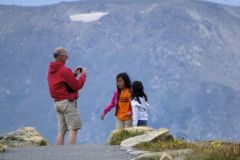
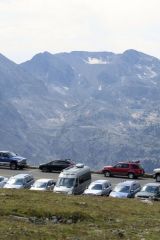
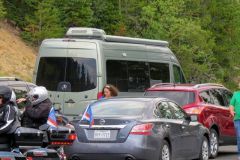

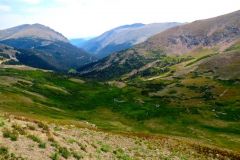
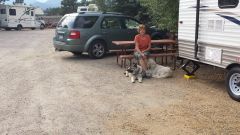
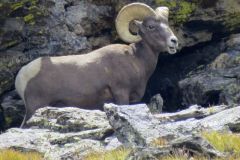
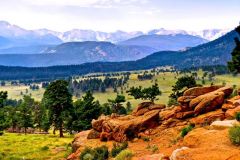
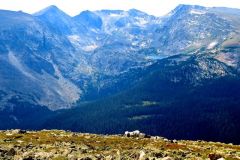
0 Comments
Recommended Comments
There are no comments to display.
Please sign in to comment
You will be able to leave a comment after signing in
Sign In Now